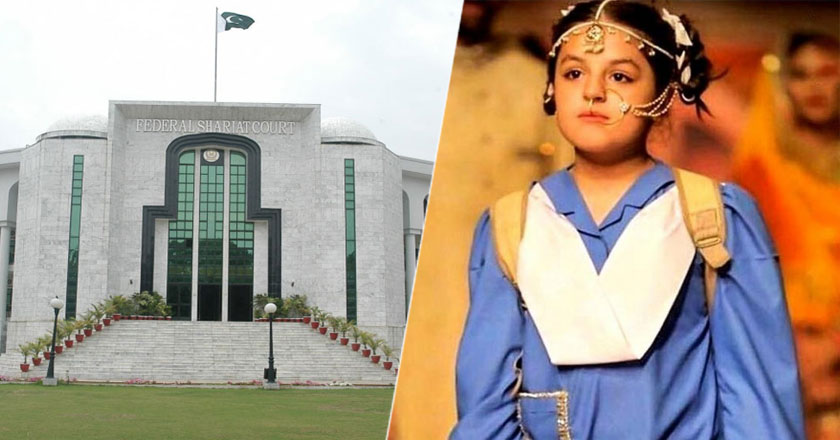The Federal Shariat Court has announced its verdict on the minimum marriage age as per the Sindh Child Marriage Restriction Act 2013 today.
The court announced that the minimum age for marriage is 18 years is not in contradiction with Islam. The bench behind the decision included sitting Chief Justice Syed Muhammad Anwar and Justice Khadim Hussain M. Sheikh.
This case was brought to light when Ali Azhar, Arzoo Fatima’s ex-husband, filed the suit, which disputed Sections 2A and 8 of the Sindh Child Marriages Restriction Act 2013.
At the time, the court dismissed the filed petition and ruled that the government has jurisdiction to set the minimum age for marriage.
Furthermore, the court found that this action did not violate any Islamic laws. On the other hand, Azhar has contended in his plea that the Sindh Child Marriages Restriction’s minimum marriage age of 18 years was not in accordance with Islamic law.
Sindh Child Marriage Restraint Act 2013
The Sindh Child Marriage Restraint Act 2013 is a law passed by the provincial assembly of Sindh, Pakistan to address the issue of marriages in the province. The law aims to protect children, especially young girls, from being forced into marriage before the age of 18. The act imposes strict penalties on those involved in arranging or facilitating child marriages and seeks to provide support to victims of child marriage.
The practice of child marriage is a prevalent problem in many parts of Pakistan, with millions of girls being married off before the age of 18. This not only violates their basic human rights but also puts them at risk of serious health problems and social isolation. Child brides are more likely to experience complications during pregnancy and childbirth, suffer from domestic abuse, and miss out on education and other opportunities.
The Sindh Child Marriage Restraint Act 2013 seeks to address these issues by prohibiting marriage under the age of 18 for both boys and girls. It also imposes strict penalties on those who violate the law, including imprisonment of up to three years and fines of up to one million rupees.
Cousin Marriages: Here’s What Studies Have to Say About This Practice
The act also aims to provide support to victims of the marriage. It establishes a toll-free helpline for reporting cases of child marriage and provides for the establishment of shelters and other support services for victims. It also requires the government to provide education and awareness-raising programs on the harms of underage marriage and the importance of girls’ education.
The Sindh Child Marriage Restraint Act 2013 is an important step towards ending child marriage in Pakistan, but there is still a long way to go. Enforcement of the law remains a challenge, and cultural attitudes towards early marriage and gender roles will need to shift to bring about lasting change.
There is a need for increased awareness and education campaigns to raise awareness about the negative impacts of child marriage on girls’ health, education, and development. The government must also work to strengthen the justice system and ensure that perpetrators of child marriage are brought to justice.
Family Planning Course May Become Mandatory for Marriage Registration: NADRA
The Ugly Impact of Underage Marriage
Child marriage is a practice that has existed for centuries in many parts of the world, including Asia, Africa, and Latin America. It is a practice in which children, especially young girls, are married off before they reach the age of 18. Child marriage is a violation of children’s human rights and has devastating consequences for both the child brides and society as a whole.
One of the most significant cons of marriage is the impact it has on the health and well-being of children. Child brides are often forced to have children at a young age, which puts them at risk of serious health problems, such as complications during pregnancy and childbirth. These complications can be fatal, and many child brides die due to childbirth-related issues. Child brides are also at a higher risk of contracting sexually transmitted infections, including HIV/AIDS.
Child marriage also has a significant impact on children’s education and development. When girls are married off at a young age, they are often forced to drop out of school, depriving them of opportunities for personal and professional growth. This, in turn, perpetuates the cycle of poverty and undermines efforts to achieve sustainable development.
Moreover, marriage or underaged children is a practice that perpetuates gender inequality and reinforces harmful social norms. It reinforces the idea that girls are inferior to boys and that their only role in society is to get married and have children. This, in turn, perpetuates the cycle of poverty and undermines efforts to achieve sustainable development.
Child marriage also has a significant impact on society as a whole. When girls are married off at a young age, they are unable to contribute fully to society, depriving society of their skills and talents. This, in turn, undermines efforts to achieve sustainable development and reduces the economic growth potential of societies.
Furthermore, child marriage is a violation of children’s human rights. Children have the right to live free from all forms of violence and exploitation, including the marriage of minors. Child marriage deprives children of their childhood and undermines their right to education, health, and well-being.
Breast Cancer: Your Waxing Lady Will Now Teach You How to Detect It, an Initiative by Indus Hospital
Stay tuned to WOW360.
